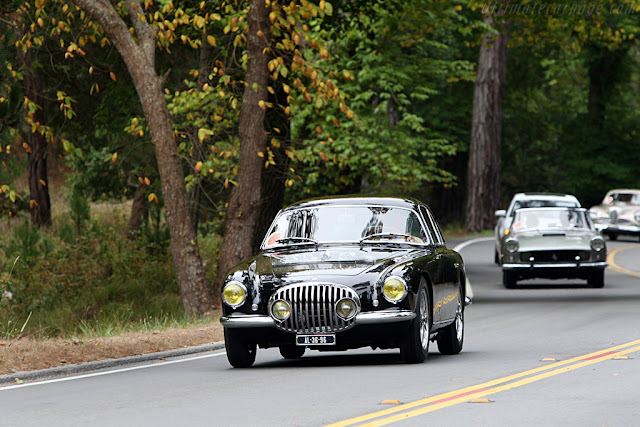Although Maserati was the world's first single-seater car manufacturer with good sports results, the company was on the verge of bankruptcy in 1937. In 1937, the remaining Maserati brothers sold their shares in the company to the Orsi family. O.S.C.A. (Officine Specializzate Costruzioni Automobili) was founded in 1947 by Ernesto Maserati and his two brothers Ettore and Bindo who had all left Maserati after their ten year contract with Adolfo Orsi terminated. There they built the OSCA sports and racing cars.
With only limited financial means available, the three brothers had to take altogether more modest approach compared to the high-tech Maseratis they had previously produced. They created the MT4 (Maserati Tipo 4) sports racer, aimed at the highly popular sub-1100 cc class. The chassis consistent of two tubular steel side members and was suspended by double wishbones at the front and a live rear axle. Power came from a four cylinder engine. The OSCA MT4 was delivered as a rolling chassis for custom coachbuilders to body.
On the track, the MT4 dominated the classes in which it ran, including the Mille Miglia, Targa Florio and Le Mans. The new 'Maserati' debuted in the 1948 Pescara Grand Prix in the hands of the well funded, but not so talented Franco Carnacchia. At the second outing the nimble OSCA was piloted by Luigi Villoresi, who promptly drove it to victory in the Napels GP. This result established OSCA as a serious manufacturer. It was the start of a very long and highly successful career for the MT4, which was continuously developed. The first modification was a slight displacement increasement to 1340 cc. After nine examples were constructed, the Maserati brothers introduced a new twin cam head late in 1949. All subsequent MT4s received this head and the 2AD (twin camshaft) type name. In 1953 a 1450 cc engine was introduced and finally a 1490 cc twin-spark engine in 1954. Producing upward of 130 bhp, these MT4 2AD 1500s were true giant slayers. OSCA's finest hour came in 1954 when Stirling Moss and Bill Lloyd, drove a 1500 MT4 (see photo below) to an overall victory in the Sebring 12 Hours against Ferraris, Lancias and Cunninghams with engines two, three and over four times the MT4's displacement. When production finally ceased in 1957 around 80 examples of the MT4 were constructed.
With class wins in every major race, it is without a doubt the most successful racing car ever constructed by the Maserati brothers. For many years the OSCAs seemed completely forgotten, but in recent years a renewed appreciation for the marque has seen prices rise rapidly. Today the MT4 is the most valuable of the so-called 'Etceterinis' built in Italy in the late 1940s and 1950s. No two examples are the same thanks to the variety of engine configurations and the even larger number of bodystyles fitted. (ultimatecarpage.com, leroux.andre.free.fr)
OSCA MT4 2AD 1500 Vignale Berlinetta
Osca's production was essentially oriented towards racing cars. Some customers nevertheless wished to have the house chassis dressed by a renowned coachbuilder, destined for a more civilian use. Four MT4s inherited closed bodies, three at Vignale (chassis 1120,1136 and 1153... see photos below) and one at Frua (chassis 1113).
1955 MT4 Berlinetta Chassis # 1153
The Giovanni Michelotti penned Vignale coupé was first shown at the 1955 Turin Show. Powered by a naturally aspirated 1,490 cc straight 8 engine that produces 125 bhp / 93 KW @ 6,300 rpm. 2 Weber 40 DCOE Carburettors. 4 speed Manual.
This is one of three Berlinettas supplied to Vignale of Turin by the OSCA Company. This car has a unique body style, and it is also the only one of the three to have the larger 1.5-liter engine. In addition to the special bodywork, other unique features include fitted luggage, plexiglass rear window, alloy filler cap and custom rear lights. Top speed 193 km/h , 0-100 km/h 7 sec. (ultimatecarpage.com)
Fine details on this exquisite car include rare OSCA and Vignale badging, king size Jaeger instrumentation, the original horn button in the steering wheel, and Marchal lights. It has factory fitted luggage (with the original keys), a plexiglas rear screen, custom made rear lights, an alloy filler cap in the boot, original tool bag and kit (with the chassis no. stamped on it). (supercars.net)
This is one of three Berlinettas supplied to Vignale of Turin by the OSCA Company. This car has a unique body style, and it is also the only one of the three to have the larger 1.5-liter engine. In addition to the special bodywork, other unique features include fitted luggage, plexiglass rear window, alloy filler cap and custom rear lights. Top speed 193 km/h , 0-100 km/h 7 sec. (ultimatecarpage.com)
Fine details on this exquisite car include rare OSCA and Vignale badging, king size Jaeger instrumentation, the original horn button in the steering wheel, and Marchal lights. It has factory fitted luggage (with the original keys), a plexiglas rear screen, custom made rear lights, an alloy filler cap in the boot, original tool bag and kit (with the chassis no. stamped on it). (supercars.net)
1953 MT4 Vignale Berlinetta #1136
1952 MT4 Le Mans Coupé Vignale #1120
Finished First in Class in the 1953 Le Mans 24 Hrs Race and 17th overall.
(Below) Stirling Moss on his way to winning the 1954 Sebring 12 hours in an
OSCA MT4 with a body by Morelli.
(Photos from ultimatecarpage.com, flaviendachet.blogspot.ca, gtplanet.net, forums.motorlegend.com, commons.wikimedia.org, supercars.net,
coachbuild.com, ferrariexperts.com, sportscardigest.com,
coachbuild.com, ferrariexperts.com, sportscardigest.com,
flickr.com, stirlingmoss.com, commons.wikimedia.org)























































